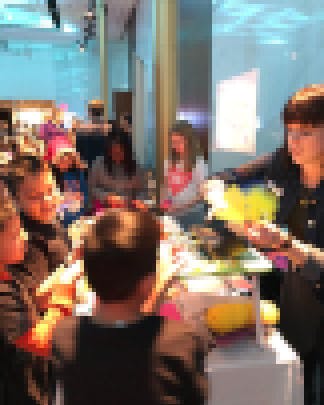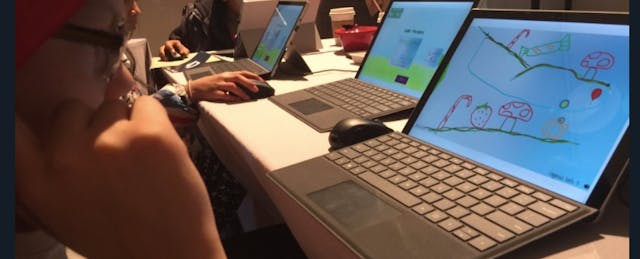What can you learn from some of the games the government has going on?For starters: Algebra, history, chemistry, English and yes, even civics and how to brush your teeth. Monday was the fifth annual ED Games Expo, held at the the famed Washington performance hall, the John F. Kennedy Center. Some 120 games, created by 80 game developers who have received support for their work from the federal government, were on hand to show off their latest creations.
And by the looks on the faces of many of the 475 school kids who showed up to try out the games and learn about what it takes to make them, the free show was a hit. Another 200 students and their families visited later in the evening.
The event was coordinated by the Small Business Innovation Research programs at the U.S. Department of Education as well as other federal departments, with support from the Entertainment Software Association. All told, 17 federal departments (including agriculture, the National Institutes of Health and the National Science Foundation) provided support for the developers. The gathering was also a warm-up act for a two-day Institute of Education Sciences research conference. That means that even though all the game developers were keen to show off the fun aspects of their games, their products are based on research and the developers were eager to talk about measuring results.

This year, 55 of the 120 games demonstrated received support from the Department of Education’s SBIR program. Those games were built by 80 developers, including 45 small business entrepreneurial developers and 35 university-based academic researcher and non-profit developers.
Although the grand atrium of the Kennedy Center more typically hosts ball gowns and Mozart fans than students with VR goggles swiping at invisible objects, the center is keen to show its appreciation for learning. “The Kennedy Center is committed to incorporating differentiated instruction and multi-modal learning in our education programs,” an official statement shared. That includes“...encourag[ing] a broad audience to consider game development as an important learning strategy.” Last year, the ED Expo featured two virtual reality games; this year it had 11. Here’s some of what we saw:
Math
Beautifully illustrated and backed by research? Math games have grown by leaps in the past six years. Among those at this year’s Expo:
Researchers at the University of Oregon showed off Numbershire and KinderTek, two math games for young children that teach foundational skills with illustrations and evidence-based practices.
Teachley, built by three female PhDs from Columbia University, offers math apps for grades 2 through 5, and uses visual models to help students learn math strategies.
BrainQuake, based in Berkeley, is expanding its Wuzzit Trouble math games and puzzles that help students develop number sense and proportional reasoning.
Empire, by MidSchoolMath, teaches math concepts through a story-based adventure game that includes trading goats and growing grain.

Science & Engineering
Brooklyn-based KillerSnails, developed by a chemistry professor, a long-time teacher and developmental psychologist, offers everything from a board game to an augmented reality game for discovering diverse creatures in biomes that range from the Pacific Ocean to the Sahara Desert.
Happy Atoms, developed by Schell Games, helps middle-school students develop an intuitive sense about molecules by building them with physical models and then exploring their properties through an app. Alchemie, aimed at high school and college students, teaches chemistry through an augmented reality app with real-time feedback on creating molecular structures.
Researchers at the University of Missouri are working on HydroSci, an eight-hour long open world game in a 3D virtual learning environment where students must solve earth science problems (say, locate a source of pollution).
Physics Playground , a game under development by researchers at Florida State University lets students experiment with Newtonian physics--and then aims to assess their persistence and creativity in solving the challenges.
With FableVision’s Fab@School Maker Studio, students can design 3D structures that are printed out on paper—and can then be assembled into models.
The Beamer wants to guide middle- and high-school students through a lush game in which they share carbon molecules with loads of creatures—from T-Rex’s to Albert EInstein.

English and …
Words Live, just launched in last November, juxtaposes contemporary song lyrics with classic texts, pairing say, a song from Jay-Z with a text by Dr. Martin Luther King. (More details here.)
Walden, a game under development by game designer-turned-professor Tracy Fulleron, aims to support “deliberate play.” The game recreates Henry David Thoreau’s Walden with historically accurate images and even recorded sounds from Concord's idyllic pond. Students engage with the plants, animals and other features of the pond, transforming Thoreau’s humanistic ideals into an open, passive, reflective, and observational style of game-play.
iCivics, a nonprofit that has built 19 games and of digital resources designed to teach the fundamentals of American civics and how U.S. democracy works to try to spur change both locally and nationally. (More than 5 million students already use iCivics; they hope to double that number by 2020).

When Games That Work isn’t building “serious” games for the military, it’s developed projects with universities and even the Texas-based charter school, the Acton Academy. One of its games is a VR app about the joys of brushing your teeth.
SBIR grants are typically awarded in two phases: Phase I awards provide about $200K for 8-months to develop a prototype of an education technology product; Phase II awards can be up to $1 million for more extensive development. The next round of Phase I applications to the Department of Education’s SBIR program are due January 25.
“It’s exciting progress to see 17 federal agencies represented here and to see the Expo grow from 10 games five years ago to more than 100. Best of all is to have the students here to play with the games and talk with the developers, ” said Ed Metz, an education research analyst for the department’s Institute of Education Sciences.


